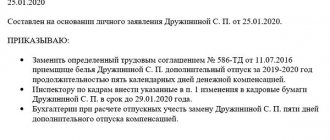Every year, both for ordinary employees and for accountants of enterprises and organizations, a busy time comes - some go on vacation, others, in connection with this, have an additional burden: calculating vacation pay. To ensure that accounting staff do not have difficulties when calculating vacation funds, there are specially developed algorithms by which they are supposed to be calculated. The same algorithms help to understand the method of calculating vacation pay to ordinary employees of enterprises and organizations without special education. We will talk about how to calculate vacation pay in different cases in this material.
Calculate the number of earned vacation days using the vacation days calculator.
How often can you take vacation?
First, let's look at how many times a year employees have the right to go on vacation. The Labor Code of the Russian Federation states that the average vacation should be 28 days according to the calendar.
At the same time, the Labor Code states that these four weeks can be divided into two or three parts, at the discretion of the employee or the management of the enterprise. It is important that one of these parts - the main one - lasts at least two weeks.
This is quite justified: not every company can afford to release valuable employees for 28 days in a row, especially in cases where this in any way affects production processes.
Right to vacation
Article 114 of the Labor Code of the Russian Federation
says that the employee is required to be given annual leave without losing his position and job.
And article 37 of the Constitution of the Russian Federation
adds that every person with official employment has this right.
You should also know that each case of determining the average salary is specified in the “ Regulation on the specifics of the procedure for calculating the average salary, approved by Decree of the Government of the Russian Federation of December 22, 2007 No. 922
».
Therefore, the amount of vacation pay and the method of calculating it will depend on factors such as the length of work in a given institution, payment of the cost of food, travel, rest, as well as whether additional bonuses and payments were given, whether sick leave was taken, etc.
Any officially employed person has every right to enjoy a 28-day vacation - as indicated in the Labor Code
.
You can take full advantage of these days, or you can divide them and rest twice a year.
When a minor gets a job, he can receive leave six months from the date of employment.
If you decide to quit after working for a certain time in the company, then under Article 127 of the Labor Code of the Russian Federation
you have every right to receive compensation for the fact that the vacation was not used.
The employer pays vacation pay within three working days.
If this does not happen, then the employee has the right to write a statement and, in addition, demand compensation.
Typically, vacation pay is classified as labor costs, which reduce income tax, and are therefore subject to personal income tax under Articles 208 and 210 of the Tax Code of the Russian Federation.
.
Also subject to personal income tax under Article 217 of the Tax Code of the Russian Federation
and compensation for unused vacation.
Payments upon reduction are not subject to personal income tax ( Article 217 of the Tax Code of the Russian Federation)
).
Rules for issuing vacation pay
The law clearly and unambiguously states that vacation pay must be issued in full to the employee no later than three days (according to the working calendar) before the next vacation. In cases of violations, the management of the enterprise may face administrative liability. But in some situations, for example on holidays, certain questions arise. Let's take a closer look at them.
- If an employee’s vacation begins immediately after the New Year holidays, then in this case vacation pay must be given to him in December, on the last working day, regardless of whether it is the 29th, 30th or 31st day of the month.
Nuance: The accountant should be aware that the general January holidays cannot be included in the vacation period established by the internal schedule of the enterprise; accordingly, vacation pay for holiday days does not need to be accrued.
Let's give an example
Employee Potemkin A.A. I decided to take a vacation from December 15, 2015 for twenty-eight days. The accounting department of the enterprise where he works must accrue vacation pay for exactly 28 days, but excluding holiday weekends.
- From the point of view of benefits, it is most interesting for an employee to take vacation in the month when, according to the calendar, the number of working days is greatest. Let's consider this statement in a specific situation;
Let's give an example
Kosulin I.T. at his own request he goes on legal leave from 01/12/2015-01/25/2015, for a total of fourteen days. Since January has a total of 15 working days, his average salary per day will be equal to 2333.33 rubles (that is, 35 thousand rubles divided by 15 days). We know that Kosulin I.T. starts work on January 26th. Thus, before the end of the month he only needs to work five days, which means his salary will be 11,666.67 rubles (2333.33 times 5 days). From further simple calculations it is clear that the difference in salary is 9627.60 rubles.
Another simple example
Salary of employee Kuznetsov K.K. is 35 thousand rubles. According to the vacation schedule developed and approved by his employer, Kuznetsov K.K. must go on vacation from December 18-31, 2015, for only two calendar weeks. There are 23 working days in December, and his average daily salary is 1521.74 rubles. (35 thousand rubles divided by 23 days). Thus, Kuznetsov K.K. The accounting department must calculate wages for days worked before vacation in the following amount: 21,304.36 rubles (i.e. 1,521.74 rubles multiplied by 14 days)
How to calculate the average daily salary for calculating vacation pay
When calculating vacation pay, an accounting employee should be aware that, in accordance with the amendment made to Article 139 of the Labor Code of the Russian Federation on April 2, 2014, a coefficient of 29.3 has been determined, which must be used when calculating vacation pay.
For example, if during working hours an employee did not take time off, was not on sick leave, or had other absences from work for any reason, then the average daily earnings are equal to the amount of payments for the estimated time, divided by 29.3 multiplied by 12.
In situations where during the billing period an employee, for some reason, did not come to work every day, his average daily earnings will be equal to the amount of payments for the billing period divided by the number of days in the billing period.
Vacation pay amount
Now you need to figure out how to calculate your daily earnings. You don't know what he is like?
It can be easily calculated by simply dividing the amount of salary for the last year by 12 months, and then by the average monthly number of calendar days - it is equal to 29.4.
Attention! Take into account only those payments that are provided for either by the employment contract or the contract of the company for which you work.
For example, various one-time bonuses and financial assistance are not taken into account.
Also remember if any month was not fully worked for one reason or another.
Vacation pay in different cases: we count it correctly
What can we say, calculating vacation pay is not always simple. It happens that at the estimated time an employee goes on sick leave or takes time off. What to do in this state of affairs, how to calculate vacation pay?
Attention! To calculate vacation pay in accordance with the law, there is a special formula. Vacation pay is calculated by multiplying the average daily earnings by the number of vacation days.
Let's look at an example
Employee Masloedov P.P. vacation starts from 1.06. 2015 Moreover, his average annual salary is 20 thousand rubles. In order to calculate the amount of his vacation pay, you need 20 thousand rubles. divide by coefficient 29.3 and multiply by 30 days. As a result of these calculations, we will come to the amount of 20,477.82 - this will be the amount of P.P. Masloedov’s vacation pay.
One more example
In this example, consider the case when, during the time that is taken as the basis for calculating vacation pay, the employee went on sick leave . So, Starshov M.M. I was going on vacation for two weeks from March 1-14, 2015. In this case, we will take the period from March 1, 2014 as the billing period. until 02/28/2015. Without further ado, let’s take the figure of 20 thousand rubles as his average salary. However, there is a nuance: Starshov M.M. from September 1-8, 2014, he was on sick leave, as a result of which he was paid sick leave in the amount of three thousand rubles. Thus, his salary for September 2014 was only 13 thousand rubles. In this situation, without racking our brains too much, we’ll calculate it like this: 20 thousand rubles. multiply by 11 + 13 thousand rubles. = 233 thousand rubles. Let's calculate the days when Starshov M.M. was at his workplace. To do this, simply multiply 29.4 by 11 + 29.4 divided by 30 (since there are 30 days in September) and multiply by (30 - = 344.96 days. It turns out that they worked 344.96 days in a year. Thus Thus, based on all the above calculations, it is clear that M.M. Starshov’s average daily earnings will be equal to 233 thousand rubles divided by 344.96 = 675.44 rubles, that is, his vacation pay for two weeks will be: 675.44 multiplied by 14 = 9456.16 rub.
So, Starshov M.M. I was going on vacation for two weeks from March 1-14, 2015. In this case, we will take the period from March 1, 2014 as the billing period. until 02/28/2015. Without further ado, let’s take the figure of 20 thousand rubles as his average salary. However, there is a nuance: Starshov M.M. from September 1-8, 2014, he was on sick leave, as a result of which he was paid sick leave in the amount of three thousand rubles. Thus, his salary for September 2014 was only 13 thousand rubles. In this situation, without racking our brains too much, we’ll calculate it like this: 20 thousand rubles. multiply by 11 + 13 thousand rubles. = 233 thousand rubles. Let's calculate the days when Starshov M.M. was at his workplace. To do this, simply multiply 29.4 by 11 + 29.4 divided by 30 (since there are 30 days in September) and multiply by (30 - = 344.96 days. It turns out that they worked 344.96 days in a year. Thus Thus, based on all the above calculations, it is clear that M.M. Starshov’s average daily earnings will be equal to 233 thousand rubles divided by 344.96 = 675.44 rubles, that is, his vacation pay for two weeks will be: 675.44 multiplied by 14 = 9456.16 rub.
Periods included in the vacation period
Time of actual work under the employment contract
This is the time when the employee fulfills the duties assigned to him under the employment contract at the workplace or on business trips.
If an employee works under a civil law contract (GPC), then his time of work is not included in the vacation period. This is due to the fact that the parties entering into a GPC agreement do not enter into an employment relationship, which means that employees with whom this type of agreement is concluded cannot, in principle, qualify for paid leave.
What to do in the case where an employee first worked under a GPC agreement, and then signed up for an employment contract? Let's look at an example. Let’s say that from February 1, 2021, the employee interacts with the employer through a civil process agreement. And since June 3, 2021, he has been working in the same company under an employment contract. Since the length of service giving the right to annual paid leave is counted from the first day of work in the company under an employment contract, the right to the first leave begins on December 4, 2021, after six months of continuous work.
Probation
During this period, the employee is subject to the provisions of labor legislation and other regulatory legal acts containing labor law norms, therefore he is included in the vacation period.
So, if an employee has been registered with the company since June 11, 2021, then, despite the fact that he has a probationary period of a month, his working year will begin no later than June 11, 2021.
Temporary periods when the employee did not actually work, but he retained his place of work (position)
The place of work (position) during this period is maintained in accordance with the legislation and other regulatory legal acts containing labor rights standards, in particular, collective agreements and employment contracts.
Such periods include the time of annual paid leave - main and additional, non-working holidays, weekends and other rest days provided to the employee.
Holidays specified in Art. 112 of the Labor Code of the Russian Federation, which will be taken into account when calculating the vacation period: New Year holidays (1, 2, 3, 4, 5, 6 and 8 January), Christmas (7 January), Defender of the Fatherland Day (23 February), International Women's Day (8 March), Spring and Labor Day (May 1), Victory Day (May 9), Russia Day (June 12), National Unity Day (November 4).
The time an employee is on study leave is included in the vacation period, since study leave is the time when the employee did not actually work, but he retained his place of work (position).
This also includes the time of receiving additional professional education, as well as the period of undergoing an independent assessment of qualifications in the direction of the employer. All of them are included in the vacation period.
Case : An employee was hired in August, 2 months later he fell ill and was on sick leave until the end of November. He had surgery at the end of November. The employee has sick leave until mid-February. Does he have the right to receive another vacation? Expert answer.
Long vacation time for teaching staff
According to Art. 335 of the Labor Code of the Russian Federation, teaching workers after a 10-year period of continuous work have the right to take a long vacation for up to one year.
Long-term leave is included in the length of service, which gives the right to annual basic paid leave. Since the procedure for granting long-term leaves to teachers is not defined by any regulatory act, you need to focus primarily on the Regulations on the procedure and conditions for granting teaching staff of educational institutions long-term leave for a period of up to one year, which was approved by Order of the Ministry of Education and Science of the Russian Federation dated May 31, 2016 No. 644.
Vacation time without pay, which is provided at the request of the employee
In Letter of Rostrud dated June 14, 2012 No. 854-6-1, such a period is limited to 14 calendar days during the working year. It also contains an important clarification: if the total duration of unpaid leave during the working year was 19 calendar days, then when calculating the length of service giving the right to annual paid leave, calendar days starting from the 15th day are not taken into account.
If any periods of time in accordance with Part 2 of Art. 121 of the Labor Code of the Russian Federation are not included in the length of service for vacation, then the end of the working year is shifted by the number of days of absence of the employee excluded from the length of service for vacation.
Case 1 : A disabled employee is entitled to 60 days of leave without pay. If the employer grants him leave without pay for more than 14 days, will the working period of the main leave shift in this case? Expert answer.
Case 2 : An employee worked for the company for 3 years, while for the last 1.5 years he was on leave without pay for family reasons; he was not on leave during the entire period. An employee is about to resign. Is he entitled to compensation for unused vacation? How many days? Expert answer.
Shift break
According to Art. 299 of the Labor Code of the Russian Federation, a shift is a general period, including the time of work performed at the site and the time of rest between shifts.
In Part 1 of Art. 297 of the Labor Code of the Russian Federation dated December 30, 2001 No. 197-FZ specifies that the rotation method is a special form of carrying out the labor process outside the place of permanent residence of workers. Shift workers are provided with rest days in accordance with the established schedule. According to Part 1 of Art. 121 of the Labor Code of the Russian Federation, the length of service that gives the right to annual basic paid leave includes the time when the employee did not actually work, but he retained his place of work (position). Based on this, it turns out that the inter-shift break should be included in the length of service giving the right to annual leave.
Rest days provided for overtime work
Overtime work should be understood as work that an employee carries out at the initiative of the employer outside the established working hours (Article 99 of the Labor Code of the Russian Federation).
Overtime work is legally limited in duration - no more than 4 hours for 2 consecutive days and 120 hours per year for each employee.
Based on Art. 152 of the Labor Code of the Russian Federation, an employee has the right to “replace” increased pay for overtime work with additional rest time, but not less than the time worked overtime.
Since in Art. 121 of the Labor Code of the Russian Federation states that the length of service that gives the right to vacation includes other days of rest provided to the employee, then the days of rest provided for overtime work are no exception in this case.
Time spent on maternity leave
At the request of a woman and in accordance with a medical report, she may be granted maternity leave. Its duration ranges from 140 to 194 calendar days, depending on the presence of complications and the number of children born. And it is fully included in the vacation period.
How to calculate vacation pay if an employee has only worked for six months
Cases where an employee has worked in a new place for only six months or a little more and is already getting ready to go on vacation happen all the time.
The right to vacation 6 months after starting work is guaranteed by Russian law.
How to calculate vacation pay in this situation?
Let's look at an example
Employee Orlov D.D. took a vacation from November 13-26, 2014. He has been on the company’s staff since April 13, 2014. His salary for partial April amounted to 20 thousand rubles. In the remaining months, in which he did not take sick leave or time off, his full salary was equal to 30 thousand rubles. Now we count vacation pay. For the billing period we take the period from 04/13/2014 to 10/31/2014. Next, we calculate the total earnings using the formula: 20 thousand rubles plus 30 thousand rubles multiplied by 6 months = 200 thousand rubles. Don’t forget about the coefficient and calculate the number of days actually worked: (18/30) multiplied by 29.3 + 6 months, multiplied by 29.3 = 193.4 days. It is easy to calculate that the average daily earnings of Orlov D.D. amounted to: 1034.1 rub. (200 thousand rubles divided by 193.4). Thus, Orlova D.D.’s vacation pay will be equal to 1034.1 multiplied by 14 days. As a result, we will receive vacation pay equal to 14,477.4 rubles.
How to calculate vacation pay if wages have changed
If your organization’s salary changes within the billing period, after the billing period, but before the employee’s vacation, or during the vacation, the amount of vacation pay will have to be recalculated.
This rule is established by clause 16 of the Decree of the Government of the Russian Federation of December 24, 2007 No. 922 “On the peculiarities of the procedure for calculating the average salary.”
Formula for calculating the vacation pay adjustment factor for salary increases
| Salary accrued for the month in which the increase occurred | : | Salary for each month of the billing period | = | Increase factor |
EXAMPLE 5. CALCULATION OF THE SALARY INCREASE RATIO
The employee’s salary in September and October 2021 was 20,000 rubles. From November 2021, the employee’s salary was increased to 24,000 rubles. - by 4,000 rubles. The salary increase coefficient is equal to: 24,000 rubles. : 20,000 rub. = 1.2.
If the salary was increased within the billing period, then the employee’s salary that he had before the increase must be multiplied by the increase factor.
EXAMPLE 6. CALCULATION OF HOLIDAY PAY WITH INCREASE RACTOR
From August 21, 2021, an employee goes on vacation for 28 calendar days. The employee’s salary was 20,000 rubles before February 1. From February 1 - 22,000 rubles. Let's calculate vacation pay for an employee: 1) Calculate the increase factor: 22,000 rubles. : 20,000 rub. = 1.1.2) We determine the months that will be included in the billing period:— August-December 2021;— January-July 2021.3) We calculate the amount of payments that we must take into account when paying for vacation:— we take into account the amount of wages before they are increased for 6 months (August 2021 - February 2021) with a coefficient of 1.1 and the amount of wages after an increase without a coefficient (February - July 2017) (RUB 20,000 × 6 months × 1.1) + (22,000 rubles × 6 months) = 264,000 rubles. 4) We calculate the average daily earnings: 264,000 rubles. : 29.3 calendar days days : 12 months = 750, 85 rubles. 5) We calculate the amount of vacation pay: 750, 85 rubles. × 28 days of vacation = 21,023.8 rubles.
It is also necessary to adjust the average earnings if the salary increase occurred outside the billing period, but before the moment when the employee went on vacation.
EXAMPLE 7. ADJUSTMENT OF HOLIDAY PAY IF SALARY IS INCREASED AFTER THE CALCULATION PERIOD BUT BEFORE THE START OF HOLIDAY
The employee goes on vacation from August 21, 2021 for 14 calendar days. Until August 1, his salary was 18,000 rubles. From August 1, the organization increased salaries, and the employee’s salary was: 21,600 rubles. Let’s calculate vacation pay: 1) Let’s calculate the increase factor: 21,600 rubles. : 18,000 rub. = 1.2.2) We determine the billing period. It will include: August-December 2021 and January-July 2021. The employee was not sick during the billing period, did not take vacation at his own expense - he worked the full period.3) Average earnings for calculating vacation pay will be: (RUB 18,000 × 12 months): 12 months. : 29.3 calendar days days = 614.33 rubles. 4) We calculate the amount of vacation pay for 14 calendar days: 614.33 rubles. × 14 calendars days = 8,600 rubles. 5) Let’s adjust the amount of vacation pay taking into account the coefficient. The salary was increased after the pay period, but before the start of the vacation. 8,600 rub. × 1.2 = 20,320 rub.
If wages increase during a vacation, which is very rare in practice, you only need to adjust that part of the average earnings that falls on the period from the moment the salary was increased until the end of the vacation.
EXAMPLE 8. ADJUSTMENT OF HOLIDAY PAY IF SALARY IS INCREASED DURING HOLIDAY
An employee goes on vacation from March 27, 2021 for 14 calendar days - until April 9. The employee's salary is 28,000 rubles. The billing period includes: March - December 2021 and January -February 2017. The employee was not sick in the last 12 months before the vacation. Worked throughout the entire billing period. On April 3, the company increased wages. The employee’s salary was 30,000 rubles. Let’s calculate the employee’s vacation pay: 1) We calculate the average earnings: (28,000 rubles × 12 months): 12 months. : 29.3 calendar days = 955.63 rubles. 2) We calculate vacation pay according to the general rule: 955.63 rubles. × 14 calendars days = RUB 13,378.82 3) During the vacation, wages were increased. Therefore, we will calculate the salary increase coefficient: 30,000 rubles: 28,000 rubles. = 1.07 Remember that wages are increased during vacation. This means that we need to adjust the part that falls on the period from April 3 to April 9, 2021 (7 calendar days). 4) Let’s calculate the amount of vacation pay for 7 calendar days that falls in the period before the salary increase. Average earnings before going on vacation was: 955.63 rubles. The amount of vacation pay for 7 calendar days (before the salary increase) was: 955.63 rubles. × 7 calendar days = 6,689.41 rubles. 5) Let's calculate the amount of vacation pay for the period during which the salary increase occurs - 7 calendar days. To do this, multiply the earnings by the increase factor. 955.63 rubles. × 7 calendar days × 1.07 = 7,157.67 rubles. 6) Calculate the total amount of vacation pay. To do this, you need to add two figures: the amount of vacation pay before and after the promotion. RUB 6,689.41 + RUB 7,157.67 = RUB 13,847.08 7) Let’s determine the amount that needs to be paid to the employee. Since vacation pay was paid to the employee before the vacation, we need to calculate the difference that is obtained when recalculating vacation pay for 7 calendar days after the salary increase with the coefficient. The difference must be paid to the employee. It is: 13,847.08 – 13,378.82 rubles. = 468.26 rub.
How to calculate vacation pay when working part-time
Employees working part-time also have the right to a full vacation of 28 days, this is guaranteed to them by Art. 93 Labor Code of the Russian Federation. This schedule does not provide for deviations from the standard calculation of vacation pay: in the same way, the average daily earnings for the last 12 months are taken into account.
Specific example
Employee Oleynikov, who worked on a salary of 20,000 rubles, is going on vacation from September 15, 2021 for the entire period of 28 days. From August 15, 2021, he switched to a part-time working schedule - a shortened working week with a salary of 15,000 rubles. Let's calculate his vacation pay.
The billing period will be the 12 months preceding the vacation: September 2021 – August 2021 inclusive.
The amount of vacation pay will be as follows. Earnings for the previous year: 20,000 x 11 + 15,000 = 235,000 rubles. Average monthly earnings: 235,000 / 12 = 19,583.3 rubles. Average daily, respectively: 19,583.3 / 29.3 = 668.4 rubles. Let's multiply by the 28 days of vacation due: Oleinikov is entitled to 18,714.44 rubles. vacation pay.
How to calculate vacation pay when summing up working hours
If an employee works in this mode, the average daily earnings cannot serve as a calculation indicator for calculating vacation pay. To do this, you need to use the criterion of average hourly earnings: the amount of money earned during the accounting period adopted by the company, divided by the number of hours actually worked during this time. The rest of the calculation procedure does not differ from the usual one.
What does this look like in an example?
The organization works according to a schedule of summarized working hours, a 40-hour week is typical. The accounting period is taken to be a month. Employee Sokolovsky, who works on a monthly salary of 40,000 rubles, was going on vacation in March 2021 for 14 days. Over the previous 12 months - from April 2021 to February 2021 - Sokolovsky worked 1,972 hours. For this year they earned: 40,000 x 12 = 480,000 rubles. Average hourly earnings will be: 480,000 / 1972 = 243.4 rubles. at one o'clock. Let's calculate how many hours of vacation need to be paid: 40 hours / 5 days (work week) x 14 days of vacation = 112 hours. Vacation pay will be: 112 x 243.4 = 27,260.8 rubles.
How to calculate vacation pay when going on vacation immediately after leaving maternity leave
Employees who are mothers have this right if they have enough work experience that gives them the right to paid leave. Child care is not included in this length of service, but maternity leave counts.
A situation arises in which the employee had partially no earnings in the previous 12-month period. In this case, the Ministry of Labor of the Russian Federation, in its letter No. 14-1/B-972 dated November 25, 2015, explains the need to replace the billing period: the countdown will begin one month before the employee goes on maternity leave.
Let's calculate using an example
Employee Kolmanovskaya, who worked at a salary of 30,000 rubles, gave birth to a child in 2014. She went on maternity leave in May 2014, it ended in September 2014, after which she took leave to care for a child up to 3 years old. In July 2017, when the maternity leave ended, Kolmanovskaya took another annual leave of 28 days. Since the billing period turned out to be incomeless, we will count vacation pay for the year preceding the maternity leave: from May 2013 to the end of April 2014. The amount of vacation pay will depend on the average daily earnings: 30,000 x 12 / 29.3 / 12 = 1023.9 rubles. Multiply by the number of days on vacation: 1023.9 x 28 = 28,668.9 rubles. This is how much vacation pay Kolmanovskaya is supposed to pay.
Vacation after maternity leave
Women should know how to calculate vacation pay after leaving maternity leave.
According to Federal Law No. 255 of December 29, 2006 “On providing benefits for temporary disability, pregnancy and childbirth to citizens subject to compulsory social insurance
» Maternity leave is not taken into account in the vacation record.
Therefore, it is necessary to determine the vacation period of an employee who is on maternity leave and returns to work.
Although there are some peculiarities here, basically the vacation pay itself is accrued according to general calculations.
Many enterprises now do not have enough extra workers, so there is a practice such as providing a certain amount of money in lieu of vacation.
Its value is calculated individually and by agreement.
Sometimes it happens differently - the company is on the verge of bankruptcy and sends its employees on forced leave.
However, by law, management is required to pay vacation pay in full.
As you can see, many situations can arise. We have covered only the most common ones.
How to calculate vacation pay for seasonal workers
Employees who have signed fixed-term employment contracts for short periods, that is, planning to work for less than 2 months, can count on paid leave at the rate of 2 days of leave per month of work. For such categories of workers, vacation pay is also calculated on the basis of average daily earnings, but this indicator will have to be calculated a little differently: the entire salary must be divided by the number of calendar days that were worked, based on a working week of 6 days.
Calculation example
A fixed-term employment contract was signed with employee Pelevanov for seasonal work for 2 summer months for a payment of 90,000 rubles. per season. During this time, he is entitled to 4 days of leave (2 days per month). If you subtract Sundays. Pelevanov worked 26 days in July, and 27 days in August, that is, 53 days in total. Pelevanov's average daily earnings will be: 90,000 / 53 = 1,698.11 rubles. For 4 days of vacation he will be credited with 1698.11 x 4 = 6,792.45 rubles.
From the above examples it is clear that in different situations, vacation pay is accrued differently. The final amount of vacation funds that the employee will receive depends on whether the employee took time off, was on sick leave, or worked the reporting period in full. A competent accountant must have a perfect understanding of all the intricacies of calculating and paying vacation pay to employees of an enterprise and take into account all the nuances when making calculations.








